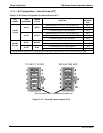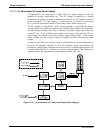
T400 Ozone Analyzer Operator’s Manual Theory of Operation
301
13.3.7.3. Photometer Temperature
In order to operate at peak efficiency the UV lamp of the instrument’s O
3
photometer is
maintained at a constant 58ºC. This is intentionally set at a temperature higher than the
ambient temperature of the T400’s operating environment to make sure that local
changes in temperature do not affect the UV Lamp. If the lamp temperature falls below
56ºC or rises above 61ºC a warning is issued by the analyzers CPU.
This temperature is controlled as described in the section on the relay PCA (Section
13.3.4.4).
The following TEST func
tions report these temperatures and are viewable from the
instrument’s front panel:
PHOTO_LAMP - The temperature of the UV Lamp reported in ºC.
SAMPLE _TEMP - The temperature of the Sample gas in the absorption tube
reported in ºC.
13.3.7.4. Photometer Gas Pressure and Flow Rate
The sensors mounted to a printed circuit board next to the internal pump (see Figure 3-5)
measure the absolute pressure and the flow rate of gas inside the photometer’s
absorption tube. This information is used by the CPU to calculate the O
3
concentration
of the sample gas (See Equation 13-3). Both of these measurements are made
downstream from the abso
rption tube but upstream of the pump. A critical flow orifice
located between the flow sensor and the pump maintains the gas flow through the
photometer at 800 cm
3
/min.
The following TEST functions are viewable from the instrument’s front panel:
SAMPL_FL- The flow rate of gas through the photometer measured in LPM.
PRES – The pressure of the gas inside the absorption tube. This pressure is
reported in inches of mercury-absolute (in-Hg-A), i.e. referenced to a vacuum (zero
absolute pressure). This is not the same as PSIG.
Note The T400 displays all pressures in inches of mercury-absolute (in-Hg-A).
Absolute pressure is the reading referenced to a vacuum or zero
absolute pressure. This method was chosen so that ambiguities of
pressure relative to ambient pressure can be avoided.
For example:
If the vacuum reading is 25" Hg relative to room pressure at sea level the
absolute pressure would be 5" Hg.
If the same absolute pressure was observed at 5000 ft altitude where the
atmospheric pressure was 5" lower, the relative pressure would drop to
20" Hg, however the absolute pressure would remain the same 5" Hg-A.
06870C DCN6332


















